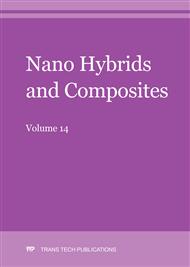[1]
A.R.K. Sasikala, A.R. Unnithan, Y.H. Yun, C.H. Park, C.S. Kim, An implantable smart magnetic nanofiber device for endoscopic hyperthermia treatment and tumor-triggered controlled drug release, Acta Biomater. 31 (2016) 122–133.
DOI: 10.1016/j.actbio.2015.12.015
Google Scholar
[2]
Y. Luo, S. Nartker, M. Wiederoder, H. Miller, D. Hochhalter, L.T. Drzal, E.C. Alocilja, Novel biosensor based on electrospun nanofiber and magnetic nanoparticles for the detection of E. coli O157: H7, IEEE Trans. Nanotechnol. 11 (2012) 676–681.
DOI: 10.1109/tnano.2011.2174801
Google Scholar
[3]
G. Ding, Y. Guo, Y. Lv, X. Liu, L. Xu, X. Zhang, A double-targeted magnetic nanocarrier with potential application in hydrophobic drug delivery, Colloids Surfaces B Biointerfaces. 91 (2012) 68–76.
DOI: 10.1016/j.colsurfb.2011.10.036
Google Scholar
[4]
T. Hoare, J. Santamaria, G.F. Goya, S. Irusta, D. Lin, S. Lau, R. Padera, R. Langer, D.S. Kohane, A magnetically triggered composite membrane for on-demand drug delivery, Nano Lett. 9 (2009) 3651–3657.
DOI: 10.1021/nl9018935
Google Scholar
[5]
R. Saadat, F. Renz, Simultaneous cancer control and diagnosis with magnetic nanohybrid materials, Beilstein J. Nanotechnol. 7 (2016) 121–125.
DOI: 10.3762/bjnano.7.14
Google Scholar
[6]
M. Saravanan, K. Bhaskar, G. Maharajan, K.S. Pillai, Ultrasonically controlled release and targeted delivery of diclofenac sodium via gelatin magnetic microspheres, Int. J. Pharm. 283 (2004) 71–82.
DOI: 10.1016/j.ijpharm.2004.06.023
Google Scholar
[7]
J.L. Arias, M.A. Ruiz, V. Gallardo, A.V. Delgado, Tegafur loading and release properties of magnetite/poly(alkylcyanoacrylate) (core/shell) nanoparticles, J. Control. Release. 125 (2008) 50–58.
DOI: 10.1016/j.jconrel.2007.09.008
Google Scholar
[8]
T. Meyer, M. Wolf, B. Dreyer, D. Unruh, C. Krüger, M. Menze, R. Sindelar, G. Klingelhöfer, F. Renz, Electrospun complexes - functionalised nanofibres, Hyperfine Interact. 237 (2016) 1–11.
DOI: 10.1007/s10751-016-1256-y
Google Scholar
[9]
J.M. Holzwarth, P.X. Ma, Biomimetic nanofibrous scaffolds for bone tissue engineering, Biomaterials. 32 (2011) 9622–9629.
DOI: 10.1016/j.biomaterials.2011.09.009
Google Scholar
[10]
S. Khansari, S. Sinha-ray, A.L. Yarin, B. Pourdeyhimi, Biopolymer-Based Nanofiber Mats and Their Mechanical Characterization, Ind. Eng. Chem. Res. 52 (2013) 15104-15113.
DOI: 10.1021/ie402246x
Google Scholar
[11]
E.Y. Gómez-Pachón, R. Vera-Graziano, R.M. Campos, Structure of poly(lactic-acid) PLA nanofibers scaffolds prepared by electrospinning, IOP Conf. Ser. Mater. Sci. Eng. 59 (2014) 12003.
DOI: 10.1088/1757-899x/59/1/012003
Google Scholar
[12]
Y. Ikada, H. Tsuji, Biodegradable polyesters for medical and ecological applications, Macromol. Rapid Commun. 21 (2000) 117–132.
DOI: 10.1002/(sici)1521-3927(20000201)21:3<117::aid-marc117>3.0.co;2-x
Google Scholar
[13]
D.E. Henton, P. Gruber, J. Lunt, J. Randall, Polylactic Acid Technology, 48674 (2000) 1841–1846.
Google Scholar
[14]
A. Wagner, V. Poursorkhabi, A.K. Mohanty, M. Misra, Analysis of Porous Electrospun Fibers from Poly( l -lactic acid)/Poly(3-hydroxybutyrate- co -3-hydroxyvalerate) Blends, ACS Sustain. Chem. Eng. 2 (2014) 1976–(1982).
DOI: 10.1021/sc5000495
Google Scholar
[15]
Y. Wan, W. Chen, J. Yang, J. Bei, S. Wang, Biodegradable poly(L-lactide)-poly(ethylene glycol) multiblock copolymer: Synthesis and evaluation of cell affinity, Biomaterials. 24 (2003) 2195–2203.
DOI: 10.1016/s0142-9612(03)00107-8
Google Scholar
[16]
E. Hendrick, M. Frey, Increasing Surface Hydrophilicity in Poly (Lactic Acid) Electrospun Fibers by Addition of Pla-b-Peg Co-Polymers., J. Eng. Fabr. Fibers. 9 (2014) 153–164.
DOI: 10.1177/155892501400900219
Google Scholar
[17]
A. Ulman, Formation and Structure of Self-Assembled Monolayers, Chem. Rev. 96 (1996) 1533–1554.
DOI: 10.1021/cr9502357
Google Scholar
[18]
G.J. Calton, Biotechnology and medicine, Cutis. 33 (1984) 375–378.
Google Scholar
[19]
M. Kumar, R. Rahikainen, D. Unruh, V.P. Hytönen, C. Delbrück, R. Sindelar, F. Renz, Mixture of PLA-PEG and Biotinylated Albumin enables Immobilization of Avidins on Electrospun Fibers., J. Biomed. Mater. Res. A. (2016) in press.
DOI: 10.1002/jbm.a.35920
Google Scholar
[20]
A. Toncheva, D. Paneva, V. Maximova, N. Manolova, I. Rashkov, Antibacterial fluoroquinolone antibiotic-containing fibrous materials from poly(l-lactide-co-d, l-lactide) prepared by electrospinning, Eur. J. Pharm. Sci. 47 (2012) 642–651.
DOI: 10.1016/j.ejps.2012.08.006
Google Scholar
[21]
S. Rana, A. Gallo, R.S. Srivastava, R.D.K. Misra, On the suitability of nanocrystalline ferrites as a magnetic carrier for drug delivery: Functionalization, conjugation and drug release kinetics, Acta Biomater. 3 (2007) 233–242.
DOI: 10.1016/j.actbio.2006.10.006
Google Scholar
[22]
M. Liu, Z. Cheng, J. Yan, L. Qiang, X. Ru, F. Liu, D. Ding, J. Li, Preparation and characterization of TiO2 nanofibers via using polylactic acid as template, J. Appl. Polym. Sci. 128 (2013) 1095–1100.
DOI: 10.1002/app.38166
Google Scholar
[23]
K. Kim, M. Yu, X. Zong, J. Chiu, D. Fang, Y.S. Seo, B.S. Hsiao, B. Chu, M. Hadjiargyrou, Control of degradation rate and hydrophilicity in electrospun non-woven poly(D, L-lactide) nanofiber scaffolds for biomedical applications, Biomaterials. 24 (2003).
DOI: 10.1016/s0142-9612(03)00407-1
Google Scholar
[24]
H.J. Lee, S.J. Lee, S. Uthaman, R.G. Thomas, H. Hyun, Y.Y. Jeong, C.S. Cho, I.K. Park, Biomedical applications of magnetically functionalized organic/inorganic hybrid nanofibers, Int. J. Mol. Sci. 16 (2015) 13661–13677.
DOI: 10.3390/ijms160613661
Google Scholar
[25]
B.D. Cullity, Introduction to magnetic materials, Addison-Wesley, Reading, MA, 1972, p.201.
Google Scholar
[26]
M.A.M. Gijs, F. Lacharme, U. Lehmann, Microfluidic applications of magnetic particles for biological analysis and catalysis, Chem. Rev. 110 (2010) 1518–1563.
DOI: 10.1021/cr9001929
Google Scholar
[27]
R.K. Singh, K.D. Patel, J.H. Lee, E.J. Lee, J.H. Kim, T.H. Kim, H.W. Kim, Potential of magnetic nanofiber scaffolds with mechanical and biological properties applicable for bone regeneration, PLoS One. 9 (2014) e91584.
DOI: 10.1371/journal.pone.0091584
Google Scholar
[28]
T.Y. Liu, S.H. Hu, T.Y. Liu, D.M. Liu, S.Y. Chen, Magnetic-sensitive behavior of intelligent ferrogels for controlled release of drug, Langmuir. 22 (2006) 5974–5978.
DOI: 10.1021/la060371e
Google Scholar
[29]
J.M. Shen, T. Yin, X.Z. Tian, F.Y. Gao, S. Xu, Surface charge-switchable polymeric magnetic nanoparticles for the controlled release of anticancer drug, ACS Appl. Mater. Interfaces. 5 (2013) 7014–7024.
DOI: 10.1021/am401277s
Google Scholar
[30]
L. Hosseini, K. Mahboobnia, M. Irani, Fabrication of PLA/MWCNT/Fe 3 O 4 composite nanofibers for leukemia cancer cells, Int. J. Polym. Mater. Polym. Biomater. 65 (2016) 176–182.
DOI: 10.1080/00914037.2015.1074912
Google Scholar


